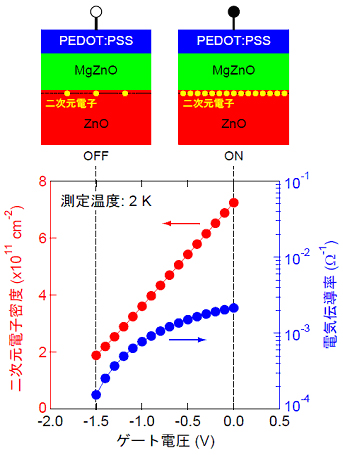Superstructured Thin Film Chemistry group (M. Kawasaki group) has successfully demonstrated the systematic control of two-dimensional (2D) electron transport at an oxide heterointerface using Schottky-gating via conducting polymer, PEDOT:PSS (poly(3,4-ethylenedioxythiophene): poly(styrenesulfonate)). PEDOT:PSS works as a good Schottky contact electrode on oxide semiconductor ZnO, due to clean organic-inorganic interface in terms of crystallographic abruptness and electronic junction properties. This achievement paves a way for such field-effect transistors with harmless, transparent, and low cost in nature. The work has been carried out in collaboration with JST for specimens partly supplied by a company, ROHM Co. Ltd. This result has become public in Advanced Materials (online publication) on November 25th, 2009 and also introduced by such press sources as The Chemical Daily (Nov. 25th, 2009), Dempa-Shinbun (Dec. 2, 2009) and Nikkan Kogyo Shimbun (Jan. 20th, 2010).

Figure:(Top) Cross-sectional device structure of a transistor composed of MgZnO/ZnO heterostructure and a conducting polymer PEDOT:PSS.
(Bottom) Gate bias dependence of the conductivity and the density of two-dimensional electron at the MgZnO/ZnO interface.
Prof. Kawasaki’s group(Superstructured Thin Film Chemistry and WPI Advanced Institute for Materials Research)
